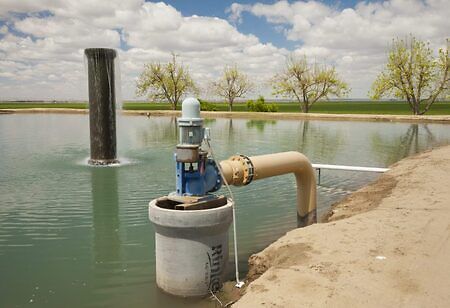
Groundwater Reservoirs Green Bangladeshi Farmers' Days in Dry Seasons


Conservation of water is another way of conserving energy. As water is an important part of our survival, it goes without saying that we must conserve water to increase the groundwater level and combat the shortage of water when the underground water level goes down drastically. Underground reservoirs are geological structures with unique features. A porous medium has some degree of permeability, and the porosity allows natural gas to be contained within the medium. Farmers from Bangladesh depend on groundwater reservoirs in dry seasons.
Bangladesh Farmers Tap Underground Reservoirs
According to reports, Bangladesh’s 16 million smallholder farmers have used groundwater through underground reservoirs rivalling the storage capacity of the world’s large dams. And the groundwater-fed irrigation had transformed much of Bangladesh’s single-crop, rain-watered floodplains into highly productive double-cropping and, in places, triple-cropping lands to make the country the world’s fourth-highest producer of rice. About 90 percent of rainfall occurs during the May to October wet season, with the rest of the year considered the dry season in the country. Reports suggest that, following droughts that hit the country between 1992 and 1994, there was a rapid increase in the use of groundwater.
Researchers say that pumping up water during the dry season reduces groundwater levels extracted from the ponds, rivers, and lakes during the monsoon months. Storage of surface water results in the recovery of groundwater levels and helps limit flooding in a process. The Bengal Water Machine is a nature-based solution, requiring a comparatively minimal intervention that is shallow irrigation wells that are less than 100 meters below ground level, which is relative to dams, to increase seasonal capture of freshwater that would otherwise drain to the Bay of Bengal.
According to the research, over the past 40 years, monsoon rainfall has recharged 75 to 90 cubic kilometers of water in Bangladesh, a volume equivalent to twice the reservoir capacity of the Three Gorges Dam in China. The phenomenon has enabled farmers to transform the country’s economy and food security and improve resilience to climate change.
In order to benefit from the operation of the Bengal Water Machine, researchers have identified the potential areas where further freshwater capture is possible under current and projected changes in monsoon rainfall and irrigation demand.
How does Groundwater Reservoir Made
Underground reservoirs have unique geographic structures and features. This medium is called a porous medium. A permeable membrane allows gas to move from point to point in the medium. Within the porous media is an impermeable membrane. This impermeable layer is usually curved or dome-shaped and prevents gasses contained in the porous medium from rising to the surface. The curvature of the overburden can also prevent the lateral movement of gas outside the porous media. In some cases, geologic faults may have caused vertical displacements in one or more faces of the gas sands, providing lateral seals. The bottom of the porous media can be sealed by impermeable rock or water.
Permeability is the ability of gas or fluids to flow through a medium with a given pressure drop. If the permeability is high, then the flow for a given pressure drop will be high.
Because flow in a permeable medium requires pressure drop, the pressure in a reservoir that is being produced will vary within the reservoir. In bore wells, the pressure will be the lowest when gas is withdrawn. Moreover, the pressure will be highest at the well bore when gas is injected into the reservoir. Hence the medium's permeability varies. In extreme cases, permeability can decrease to zero and seal off a portion of the reservoir. This is called a permeability pinch-out. When a field is shut in, it may take a very long time for the pressure to stabilize throughout the field.
Underground reservoirs, also known as sumps, serve as suction sources for pumps. These reservoirs normally are built at the site of a supply source. It is common to design a pump station where a number of well pumps discharge to an onsite reservoir. Water treatment plants also commonly have large reservoirs to hold treated water. Service pumps draw water from the reservoir and release it into the transmission and distribution system. The reservoir at the water treatment plant or well source can be either completely buried, partially buried, or completely above grade. The onsite reservoir at each well site can help to solve potential water quality problems. Water discharged from wells often contains dissolved gasses and slit or grit. If this water goes through a reservoir, the gasses will dissipate, and the grit will settle to the reservoir bottom, and these problems could be eliminated. These underground reservoirs can also be used to provide storage for a portion of the overall storage volume needed in the system.
Types of Underground Reservoirs
Underground reservoirs can be classified into two types: volumetric reservoirs and water-drive reservoirs. Volumetric reservoirs are coated with the sides by impermeable rock and act like pressure vessels. The structural coat, by geologic characteristics, keeps its size and shape constant. The water drive reservoir is coated on the top and sides by impermeable rock but is sealed on the bottom by water. It may be considered a bucket inverted in a body of water. As the quantity of the gas supply increases to the bucket, water is forced out, and the size of the gas bubble inside the bucket increases. The forcing back of the water may occur by two mechanisms. In one mechanism, the gas and a very large amount of water are contained in a large sealed reservoir of constant volume. When the gas is introduced into the reservoir, the increased pressure causes the water to be compressed. Due to the compressibility of water being quite small, a substantial volume of water is required to enlarge the gas bubble. The second mechanism is where the gas pushes the water out of the storage reservoir to another reservoir or location.

